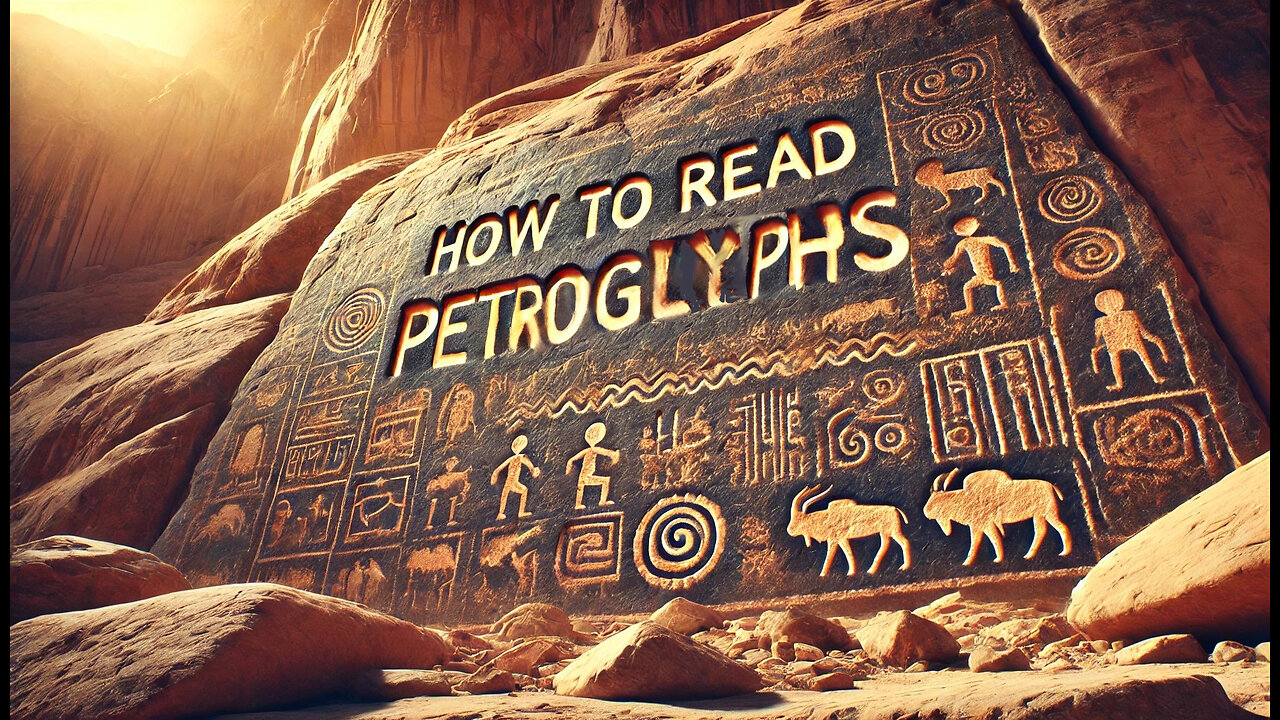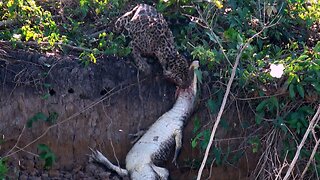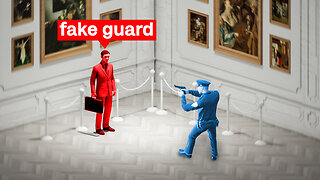Premium Only Content

Petroglyphs: The First Language
Across continents and millennia, scattered petroglyphs and cave murals reveal a recurring visual language—a large human figure, a smaller counterpart, a connecting rope or conduit, and a trident-shaped symbol. Though these images appear in isolation at distant sites—Juxtlahuaca Cave in Mexico, Bir Hima in Arabia, and Jubbah in northern Saudi Arabia—they share a visual structure too consistent to be coincidence. What emerges is not a story or myth, but a system: a grammar of transmission, visible in stone, embodying continuity beyond time or culture.
At Juxtlahuaca, the journey into meaning begins with descent. Bodies of the dead line the path, calcified in upright postures, standing as ancestral markers. A carved trench leads inward, ending in three painted panels: a jaguar breathing flame, a feathered serpent in motion, and a human figure marked with glyphs, holding a rope and extending a trident-shaped object. These images form a triadic chain—source, transmission, reception—not merely in narrative but in function. The structure of legacy itself is diagrammed through pigment and space.
Bir Hima distills this same structure into a sharper, starker form. A tall central figure holds both a rope and a blade, standing between a disembodied head and a crouched figure. Tridents appear again—one upright, one negated, and one implied in the man’s own form. Here, the visual logic evolves: the central figure is no longer only a recipient, but a judge, a point of balance between affirmation and rejection. The message is no longer only passed—it is weighed.
At Jubbah, the figures become aware of themselves. The central man turns his head, reflecting back on the chain of inheritance. The trident, once held in the hand, now appears within the mind. A sheep segmented in three, a glyph resembling Aleph, and the final symbol—a bisected circle—reveal the structure not just of legacy, but of thought itself. The visual language transforms into proto-syntax: a progression from structure, to life, to culmination. Here, man begins not only to receive or judge meaning, but to generate it.
What these three sites depict is not mythic storytelling, but cognitive architecture. They show how early humans conceived of continuity—not through voice or script, but through visual relationships: source, conduit, recipient. These were not isolated moments of creativity, but convergences on a shared structure of understanding. And at the center of it all is the trident—not an ornament, but a structural operator, embodying the unity of three-in-one: giver, passage, receiver.
This triadic system transcends art. It appears in ancestral lineage, teaching, memory, and ritual. It reflects developmental logics in language, genetics, and consciousness. It precedes spoken or written word, yet conveys information with astonishing precision. It shows that long before alphabets, there existed a grammar of relation—a visual infrastructure capable of bearing meaning across generations.
Taken together, Juxtlahuaca, Bir Hima, and Jubbah compose not a mythology, but a blueprint. They reveal that meaning, in its oldest form, was always structural. That to understand something—truly—is to place it within a triad: to locate its origin, map its medium, and pass it forward. The trident is not just a symbol within the art. It is the art’s logic itself—and we, now seeing it clearly, become the next receivers in this enduring sequence of thought.
#AncientArt #Archaeology #CognitiveArchaeology #SymbolicSystems #Petroglyphs #CaveArt #Juxtlahuaca #BirHima #Jubbah #PrehistoricSymbols #VisualLanguage #Semiotics #HumanOrigins #MesoamericanArt #RockArt #TriadicStructure #Anthropology #AncientWisdom #VisualGrammar #SacredGeometry #MythAndMeaning #EarlyCognition #CrossCulturalPatterns #SymbolicThought #TridentStructure
-
 LIVE
LIVE
BEK TV
22 hours agoTrent Loos in the Morning - 9/03/2025
399 watching -
 LIVE
LIVE
The Bubba Army
21 hours agoNick Hogan Sues Bubba to BLOCK the DOC - Bubba the Love Sponge® Show | 9/03/25
5,403 watching -
 8:01
8:01
MattMorseTV
12 hours ago $10.19 earnedHe's ACTUALLY doing it...
70.5K60 -
 33:25
33:25
Uncommon Sense In Current Times
15 hours ago $1.80 earnedHollywood’s Woke Agenda Exposed | Kevin Sorbo on Cancel Culture, Faith & the Common Sense Revolution
18K -
 8:23
8:23
The Art of Improvement
19 hours ago $0.46 earned7 Smart Habits to Boost Mental Clarity
2.37K2 -
 12:09
12:09
China Uncensored
11 hours agoI Have NEVER Been More Furious
3.98K17 -
 2:12
2:12
WildCreatures
4 days ago $0.83 earnedThe beauty and mystery of the Pantanal, Brazil's best secret
4.17K2 -
 9:38
9:38
Millionaire Mentor
18 hours agoBernie Sanders LOSES IT After Scott Bessent’s Shocking Comeback
3.55K8 -
 1:35:35
1:35:35
Dialogue works
1 day ago $0.54 earnedLarry C. Johnson & Paul Craig Roberts: Trump’s Plan COLLAPSES as Russia Strikes — Xi & Modi Rise!
2.87K3 -
 14:09
14:09
Zoufry
2 days agoThe Hunt for The Biggest Art Thief in US History
6.98K3